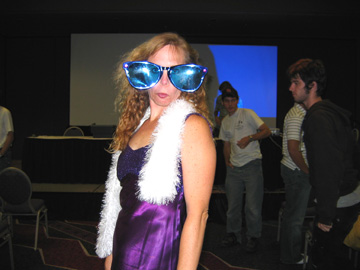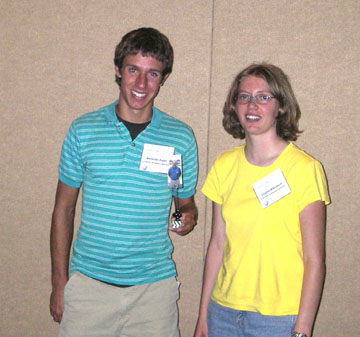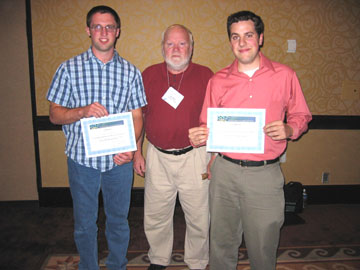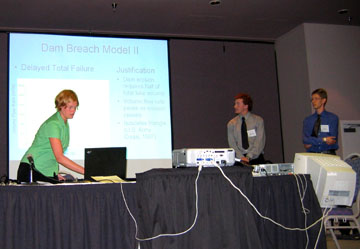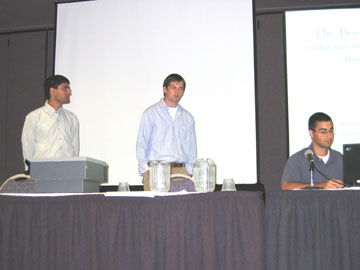- About MAA
- Membership
- MAA Publications
- Periodicals
- Blogs
- MAA Book Series
- MAA Press (an imprint of the AMS)
- MAA Notes
- MAA Reviews
- Mathematical Communication
- Information for Libraries
- Author Resources
- Advertise with MAA
- Meetings
- Competitions
- Programs
- Communities
- MAA Sections
- SIGMAA
- MAA Connect
- Students
- MAA Awards
- Awards Booklets
- Writing Awards
- Teaching Awards
- Service Awards
- Research Awards
- Lecture Awards
- Putnam Competition Individual and Team Winners
- D. E. Shaw Group AMC 8 Awards & Certificates
- Maryam Mirzakhani AMC 10 A Awards & Certificates
- Two Sigma AMC 10 B Awards & Certificates
- Jane Street AMC 12 A Awards & Certificates
- Akamai AMC 12 B Awards & Certificates
- High School Teachers
- News
You are here
MAA Student Chapters Newsletters - Fall 2005
Fall 2005
Introduction Albuquerque Activities Report Set Your Sights on San Antonio CreditsIntroduction
The Joint Mathematics Meetings in San Antonio
Enjoy the mild weather and the river walk of
MathFest
2005: Albuquerque
Albuquerque Activities
Albuquerque
Student Reception
The annual MAA/PME Student Reception was held on Wednesday, August 3, from 5:30 to 6:30 p.m. in the Fiesta Room of the Hyatt Hotel. More than one hundred students, advisors, and MAA/PME officers attended this opening event for MathFest 2005. The student reception has become a tradition at the summer meeting of the MAA. It is generally held right before the Opening Banquet and precedes the first full day of mathematics talks. It is a relaxed, fun event at which students can meet each other and be welcomed by established mathematicians. We hope to see you at the reception in Knoxville next summer! |
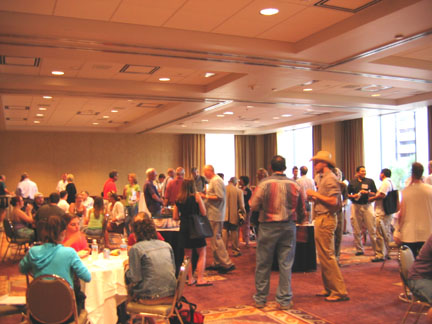 |
||||
Student Activities Session: Walking on Long Paths
by Betty Mayfield
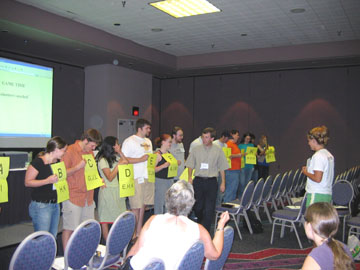 |
|
For two hours on Saturday afternoon, August 6th, the Brazos Room of the Albuquerque Convention Center was alive with undergraduate ’vertices,â? armed with the names of their ’friends,â? attempting to form the longest possible chain in a graph. This scene was part of the MAA student workshop, led this year by John Harris of Furman University. Prof. Harris started with some simple, familiar definitions (vertices, edges, Euler and Hamiltonian paths) and quickly moved on to some open research questions in graph theory. Faculty advisors later reported that, at dinner that night, their students could not stop talking about the workshop. The event, a tradition at MathFest, features a mathematician leading students in a hands-on, dynamic session. It is fun and instructive and often introduces students to new areas of mathematics. Many thanks to Prof. Harris for an excellent workshop this summer. Join us next year in Knoxville, when our activities leader will be James Tanton, author of Solve This! Math Activities for Students and Clubs. |
|
Lights, Camera, Freeze!
by Mario Martelli
The MAA Student Lecture by Annalisa Crannell from Franklin & Marshall College and Marc Franz from Indiana University was very well received by the audience of students and faculty. It was informative, entertaining, and challenging at the same time. Here is a brief abstract of the two authors’ effort. Director/Producer Stephen "Marc" Frantzberg teamed up with the world-famous actress Annalisa Monalisa Cranberry to bring us the new blockbuster hit, Projection. Spanning the centuries between Renaissance perspective painting and modern cinematic special effects, Projection revealed the true secrets behind projecting a 3-dimensional world onto a 2-dimensional canvas (or movie screen). We laughed, we cried, and reached the vanishing point. The key part was to "project a 3-dimensional world onto a 2-dimensional canvas (or movie screen)". The two speakers explained what a "vanishing point" means mathematically, talked about how to find the correct viewing position for a perspective piece, and showed how cute perspective tricks are used in Hollywood movies. Marc Frantz and Annalisa Crannell teamed up initially in 1995 as part of a Math Across the Curriculum (MATC) grant that the NSF awarded to Indiana University. Over the years, they have developed a bunch of classroom materials that use real art problems (like, if you draw two fence posts along a road that goes back into the distance, where do you place the next fence posts?) that require interesting mathematical solutions. They did run a series of summer workshops (called "Viewpoints") for instructors in mathematics and/or art on using these materials, and they are currently writing a textbook which is funded by NSF and which will be published by Princeton University Press. |
|
||||
| Professor Annalisa Crannell as the movie
star Annalisa Monalisa Cranberry |
by Ed Keppelmann
by Ben Fusaro
The two MAA Winners of the 2005
Mathematical Contest in Modeling’Duke University, NC and the University
of Saskatchewan, Saskatoon’presented their results on Saturday
afternoon. This COMAP-sponsored contest consists of two
open-ended problems, a continuous one and a discrete one.
The teams had three full days to construct their models and write up their results. Each team member had only a few minutes to present at MathFest, and they made efficient use of power point presentations, leaving the audience very impressed. The full problem statements are rather long and can be found at http://www.comap.com/undergraduate/contests/mcm/contests/2005/problems/ The faculty advisor for the Saskatchewan team is Professor James A. Brooke, and for the Duke team it is Professor W. Garrett Mitchener. The MCM judges were Kathleen Shannon, Salisbury University, MD, and Marie Vanisko, Stanislaus State University, CA. |
|||||||||||
by Richard Neal
A Duke student won first place
in the 2005 U. S. National Collegiate Mathematics Championship held at
MathFest in Albuquerque. Pradeep Baliga, a 21-year-old Duke
senior, finished all 7 problems posed to him before the rest of the
field. Second place went to Gregory Minton, a sophomore at Harvey
Mudd College. Harvey Mudd has had continual placers in the USNCMC
in past years including the first-place finisher last year. Third
place went to Adam Chandler, a senior from Duke University.
Fourth place went to Patrick Dixon, a senior from Occidental
College. The seven problems presented to the students at the
USNCMC call for a diverse background of mathematics knowledge and
skill. The USNCMC is the finals for The Problem Solving
Competition, a monthly mathematics problem solving contest held locally
at hundreds of colleges and universities in the United States and other
countries. This year, 150 additional colleges have registered for
the monthly problems and The Problem Solving Competition. There
is no charge for the monthly competition and there is no entry fee for
your students to compete in the MathFest championship. All competitors
receive beautiful red white and blue medallions and T-shirts. The
first four finishers receive plaques in the shape of the United
States. Texas Instruments provides computer prizes for the
championship.
|
Student Hospitality Center
by Richard Neal
The Student Hospitality Center at MathFest in Albuquerque was located in the center of the action in the exhibits area across from the email area. There were more than 100 visitors each day of the meeting. Many student visitors congregated and discussed their presentations and talks, socialized, and enjoyed the free refreshments. The Student Hospitality Center is sponsored by the MAA Committee on Undergraduate Student Activities and Chapters. It has become a place to keep up with the flow of the meeting, to leave messages, to meet others and talk, or just to relax between sessions. Programs for the student talks, Pi Mu Epsilon T-shirts, MAA T-shirts, and other materials such as transparencies and markers were available for students. Judges picked up their packets at the center. Handouts and announcements to chapter advisors and students were also available. Please look for the Student Hospitality Center at the Joint Winter meetings as well as at MathFest each year. |
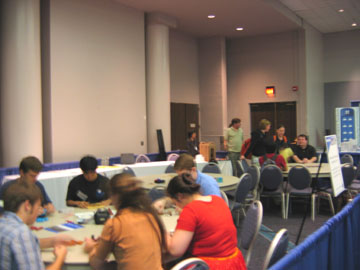 |
Back to Top
Set Your Sights on San Antonio
Undergraduate Poster Session
| The January 2006 Undergraduate
Research Poster Competition will be held at the Joint Mathematics
Meetings in San Antonio on Saturday, January 14, 2006 from 4:00-6:30
pm. Please encourage students who have completed an undergraduate
research project to submit their abstracts online at /students/undergrad/poster06.html. We are also seeking judges for the competition. If you or your colleagues are interested in judging the contest, they can submit their information online at /students/undergrad/judges06.html. We are looking forward to your participation in January! For more information please contact Diana Thomas at thomasdia@mail.montclair.edu. |
|
Outside the Classroom
The Contributed Paper Session titled ’Research and Other Mathematical Experiences for Students outside the Classroomâ? is organized by the MAA Committee on Undergraduate Student Activities and Chapters and by the CUPM Subcommittee on Undergraduate Research. Here is a summary of the session:
The contact organizer is: Kay Somers, Moravian College, mekbs01@moravian.edu. Co-organizers are: Susan Morey, Texas State University; Sivaram K. Narayan, Central Michigan University; Jody Sorensen, Grand Valley State University.Mathematics "happens" both inside and outside the classroom and, in fact, many mathematics majors are drawn to the subject through a special event sponsored by a Student Chapter or Math Club or through special research projects and programs. This session seeks presentations by academic, industrial, business, and/or student mathematicians so that the audience will be encouraged to organize and run special events for their students. Descriptions of activities could include, but are not limited to, special lectures, workshops for students, Math Days/Fairs, student conferences, recreational mathematics activities, problem solving activities and contests, general community-building activities, and student consulting projects. We especially encourage information about student research projects and programs, including program logistics and project ideas. Information on how such activities are organized and carried out, what activities especially grab students’ interests, how students are contacted and encouraged to participate, and how the events are funded will be especially helpful.
MAA Student Lecture
Even as an undergraduate, Chamberland distinguished himself, scoring in the top 3% of all participants in the Putnam competition and spending two summers conducting research with the assistance of a summer research scholarship. As a faculty member, he has directed many undergraduate students in their own research, helping to train a new generation of young mathematicians.
Dr. Chamberland will speak to us in San Antonio on ’The Many Faces of Pi.â? This talk brings together ancient and cutting edge results, results related to analysis, geometry, probability, and theoretical computer science. He will also give us a look at some of the people involved in the history of pi ’ some human faces related to the topic.
MAA Diversity Initiative
CUSAC administers a small grant program called the MAA Diversity Initiative, designed to help college faculty bring students from under-represented groups to the Joint Meetings. Institutions may apply for travel mini-grants of up to $500 per college or university, to cover some of the costs of registration, travel, and housing. Last year faculty from fourteen institutions received grants to bring 53 students to the meetings in Atlanta.
Information about the program has been sent to directors of NREUP summer programs and to institutions in Texas, but we welcome applications from any faculty member who plans to bring students to the JMM who would help to add a little diversity to our numbers. For information and an application, contact Betty Mayfield: Mayfield@hood.edu. Deadline is December 1st.
The joint PME and MAA Student Chapter Advisors' Breakfast is scheduled for Saturday, 7:00 a.m. to 8:00 a.m.
Also of Interest to Students
Here is the schedule for some other events of interest to undergraduates extracted from http://www.ams.org/amsmtgs/2095_students.html. I have also learned that there will be a contributed papers session on ’my three favorite calculus problems.â?
Undergraduate Career Paths in Mathematics, Friday, 9:00 a.m. to 10:20 a.m.
What Business Looks for in New Hires, Friday, 2:30 p.m. to 3:50 p.m.
Transitioning into Graduate School, Saturday, 9:00 a.m. to 10:20 a.m.
MAA Student Research Programs, Sunday, 1:00 p.m. to 2:20 p.m.
Credits
Photos: Student Lecture photo #1’Mario Martelli; Student Paper Sessions #1’Paul Fishback, Grand Valley State University, #2 & #3’Hal Nesbitt, MAA; others’Editor.
How to Reach the MAA
The MAA Service Center
P.O. Box 9112
Washington, DC 20090-1622
800-331-1622 or (301)617-9415
FAX: (301) 206-9789
For the MAA Headquarters:
The Mathematical Association of1529 Eighteenth Street, NW
Washington, DC 20036-1385
800-741-9415 or (202) 387-5200
FAX: (202) 265-2384
How
to Contact the Chapter Newsletter Editor
Suggestions,
concerns, and/or contributions of articles for the CUSAC newsletter may
be sent to:
John
Holte
Department of Mathematics and Computer
Science
Gustavus Adolphus College
800 W. College Avenue
St. Peter, MN 56082
(507) 933 - 7465
holte@gustavus.edu


